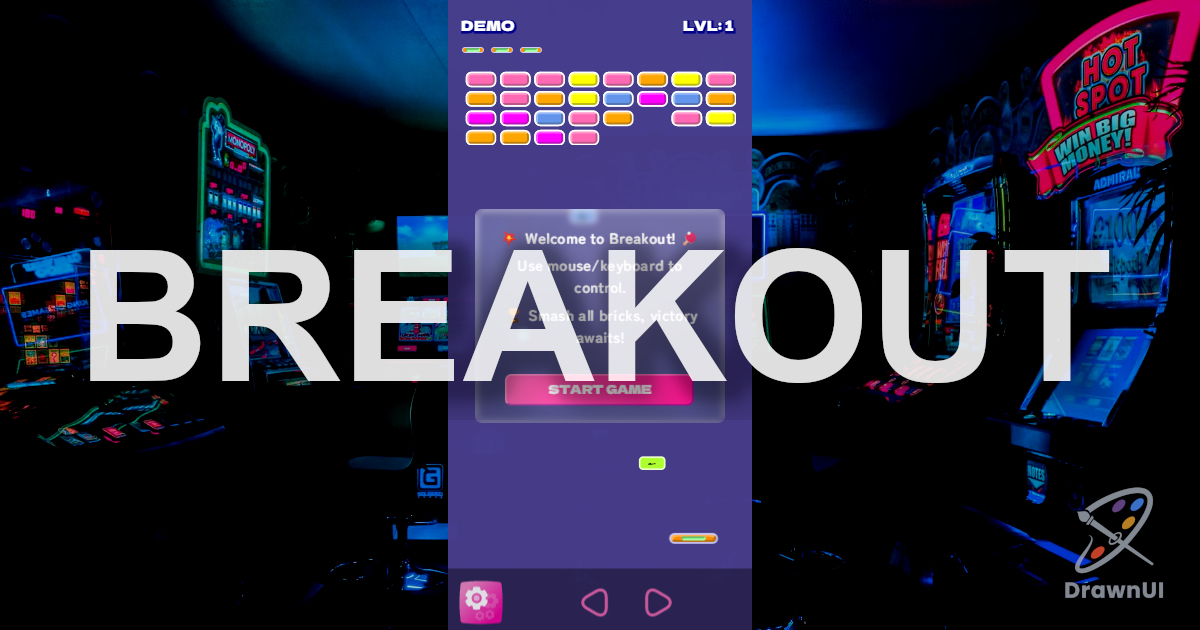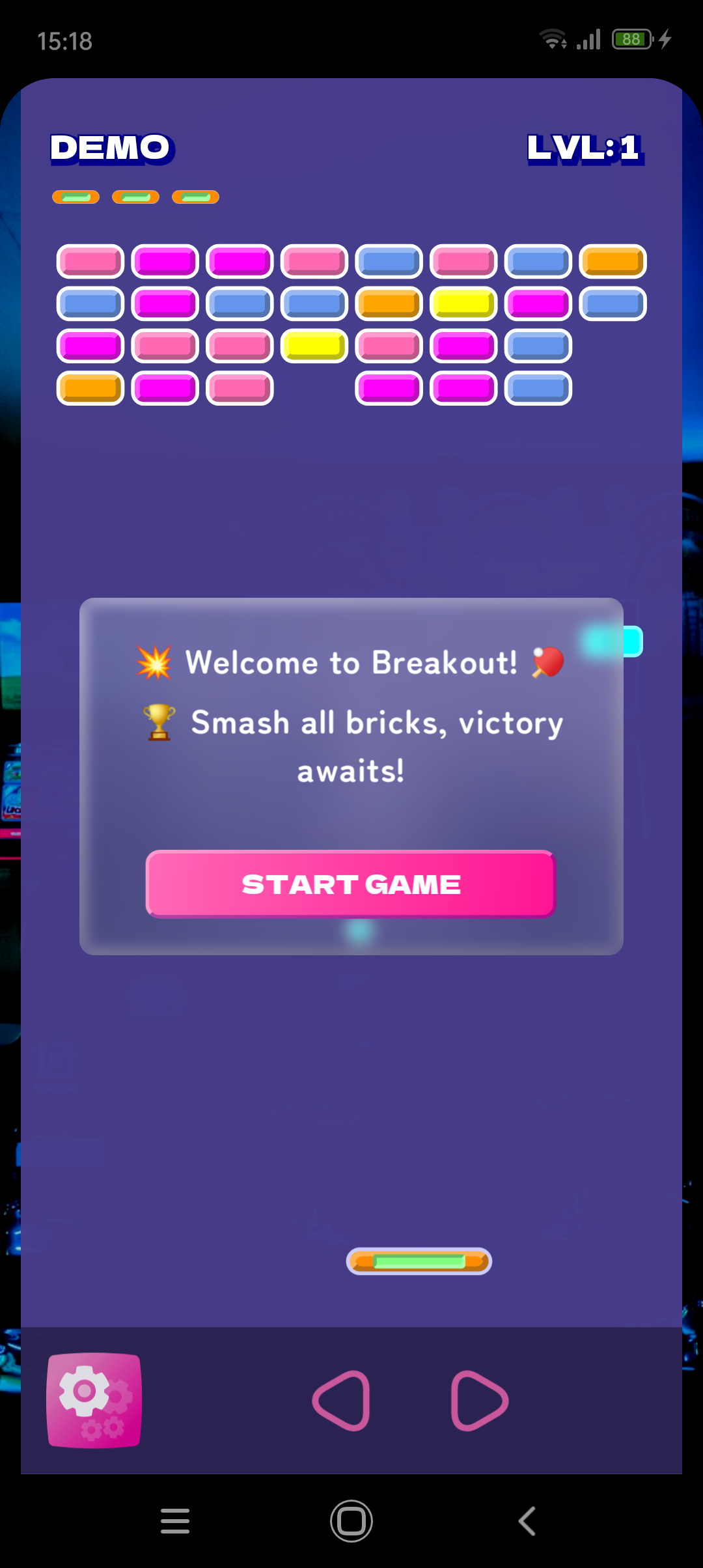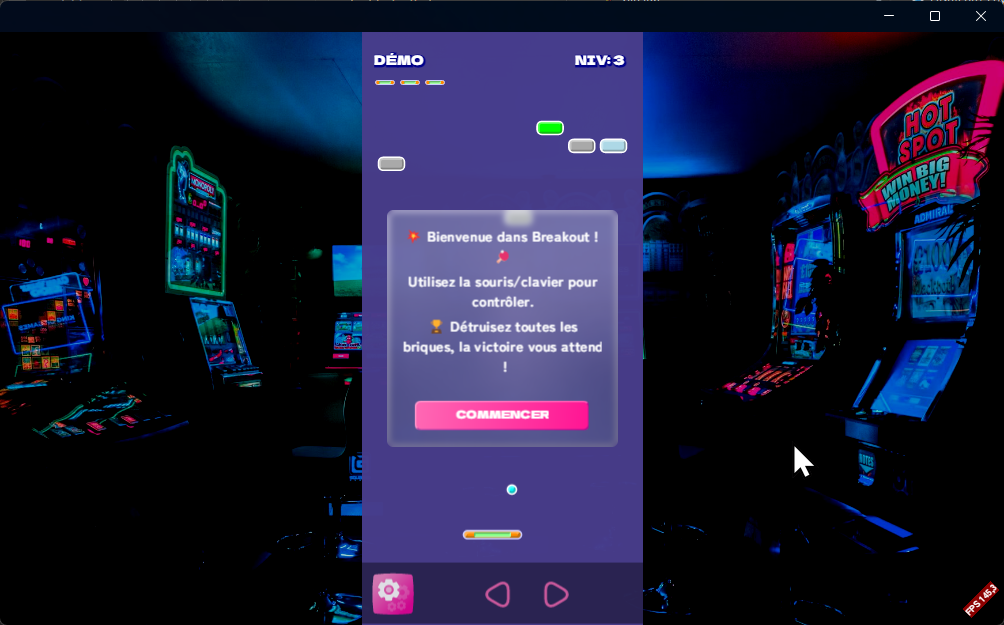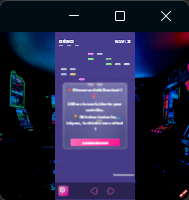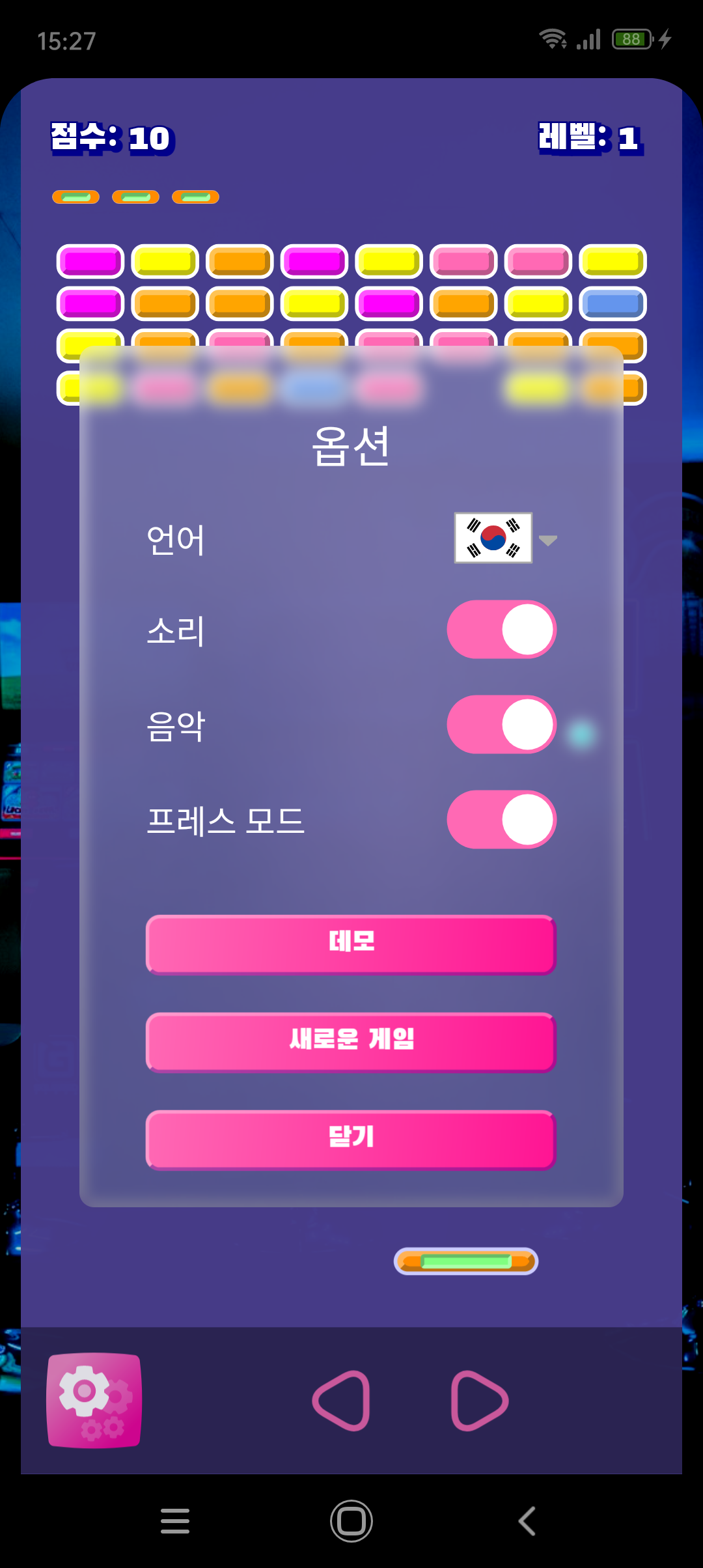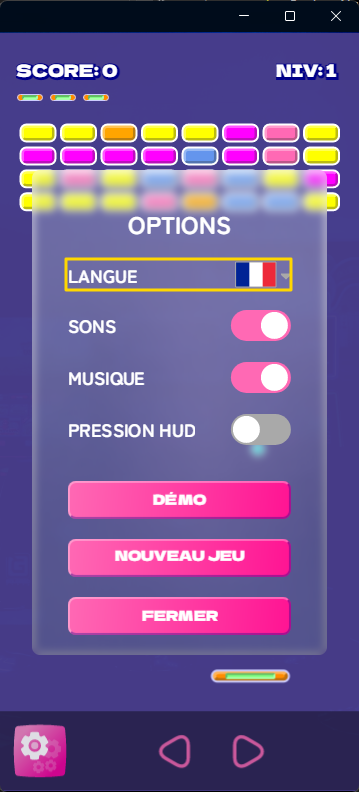Breakout: Building A Cross-Platform Game in .NET MAUI with DrawnUI and Hot Preview
Building a feature-rich Breakout game with DrawnUI's hardware-accelerated canvas, object pooling, and Hot Preview for instant development feedback.
Building A Cross-Platform Game in .NET MAUI with DrawnUI and Hot Preview
This is my third game etude for .NET MAUI after SpaceShooter and Doom.Mobile. We will discuss the creation of the Breakout game in .NET MAUI as well as how this experience could be used for creating other games to be played on platforms .NET MAUI supports: Android, iOS, MacCatalyst, Windows.
Breakout Game Features
- 12 levels of Breakout madness!
- Catch powerups destroying the bricks!
- If you are lucky enough shoot at bricks in Destroyer mode!
- Discover hidden music by catching rare powerups
- Auto-generated levels
- Available in 9 languages: English, German, Spanish, French, Russian, Italian, Japanese, Korean, Chinese
- Play with touch/keyboard/mouse/Apple controllers
Breakout game’s welcome screen on Android phone showcasing the colorful brick layout and modern UI design. AI bot is playing paddle in demo mode. Created with DrawnUI for .NET MAUI.
The Challenge: Beyond Traditional MAUI Apps
When working with .NET MAUI we are so used to making business apps that making a game can become a dream to fulfill.
And preferably still in MAUI to stay in the comfort zone. But what tools to use? Should I place sprites inside a Grid and use translation for positioning them?
If you’ve already been looking at how to escape from a predefined set of controls to a “draw what you want” concept you might already have tried SkiaSharp. The library that exposes the Skia cross-platform rendering library to the .NET world and we can draw something new we imagined.
To tell the truth at some point I fail to visualize in my head the end result of all the “draw path, close path, draw surface” etc so to draw on a game canvas it would be great to use something really abstract. The ideal would be to use a familiar layout system with LayoutOptions known by heart, to arrange controls that would draw what I want just by changing bindable properties.
When looking at the game screenshot above you might have wondered “are those SVG or something, or they draw images for bricks”? Well, not at all:
1
2
3
4
5
6
7
8
9
10
11
12
13
14
15
16
17
18
19
20
21
22
23
24
25
public class BrickSprite : SkiaShape, IWithHitBox, IReusableSprite
{
public static BrickSprite Create()
{
return new BrickSprite
{
UseCache = SkiaCacheType.Operations,
BackgroundColor = Colors.Red,
CornerRadius = 6,
WidthRequest = 50,
HeightRequest = 24,
StrokeColor = Colors.White,
StrokeWidth = 2,
BevelType = BevelType.Bevel,
Bevel = new SkiaBevel()
{
Depth = 4,
LightColor = Colors.White,
ShadowColor = Color.Parse("#333333"),
Opacity = 0.33
},
ZIndex = 4
};
}
}
That’s our brick, and it already feels better seeing WidthRequest and other familiar properties, this suggests it could maybe even be placed inside a layout with some manual offsets like “TranslationX” or something. Not only this, it looks like this all is on points and would be scaled to any display size.
Controls As Sprites
Using the DrawnUI NuGet I can place drawn custom controls inside a hardware-accelerated canvas with a familiar WPF-like layout system and draw text, shapes, shadows and other effects by just setting bindable properties, without really caring about how this is all is drawn with Skia. Inside a MAUI-like layout experience we use intuitive concepts like SkiaLabel, SkiaShape, SkiaLayout and more.
Now every single sprite in the game is basically just a styled control:
1
2
3
4
5
6
7
8
9
10
11
12
13
14
15
16
17
18
19
20
21
22
23
24
25
26
27
28
29
30
31
32
33
34
35
36
37
public class BallSprite : SkiaShape, IWithHitBox, IReusableSprite
{
public BallSprite()
{
UseCache = SkiaCacheType.GPU;
HeightRequest = 15;
HorizontalOptions = LayoutOptions.Center;
VerticalOptions = LayoutOptions.End;
Type = ShapeType.Circle;
StrokeColor = Colors.White;
StrokeWidth = 2;
LockRatio = 1;
BackgroundColor = Colors.Aqua;
SpeedRatio = 1;
IsActive = true;
BevelType = BevelType.Bevel;
Bevel = new SkiaBevel()
{
Depth = 4,
LightColor = Colors.White,
ShadowColor = Color.Parse("#333333"),
Opacity = 0.33
};
}
// Ball can transform into a fireball with powerup
public bool IsFireball { get; set; }
public void UpdatePosition(float deltaSeconds)
{
float moveX = BreakoutGame.BALL_SPEED * SpeedRatio * MathF.Cos(Angle) * deltaSeconds;
float moveY = BreakoutGame.BALL_SPEED * SpeedRatio * MathF.Sin(Angle) * deltaSeconds;
Left += moveX;
Top += moveY;
}
}
Controls can be placed inside layouts similar to vertical stack, horizontal stack, absolute (think MAUI Grid with 1 col/row) etc. We can apply many types of transforms here and obviously we could move objects with TranslationX and TranslationY.
So in a usual scenario you could do a simple Ball.TranslationX = positionOffsetX to move horizontally.
But in this new etude I was using another custom set of displacement properties Left and Top. Why not usual translations: while optimizing for max FPS-performance it felt better to avoid applying a transformation matrix when it wasn’t required. Instead when a control is cached we can use Left and Top just to offset control’s cache, no matrix transforms involved.
A Drawn App
MainPage
Usually there is MainPage.xaml and here we have MainPage but that supports .NET HotReload. Instead of using XAML we build the UI in code using the Build() method.
The app structure is quite simple:
1
2
3
4
5
6
7
8
9
10
11
12
13
14
15
16
17
18
19
20
21
22
23
24
25
26
27
28
29
30
31
32
33
34
35
36
37
38
39
40
41
42
public partial class MainPage : BasePageReloadable
{
Canvas Canvas;
// This is called by constructor and .NET HotReload
public override void Build()
{
Canvas?.Dispose();
Canvas = new Canvas()
{
Content = new SkiaLayer()
{
Children =
{
//WALLPAPER
new SkiaImage(@"Images/back.jpg")
{
UseCache = SkiaCacheType.Image,
AddEffect = SkiaImageEffect.Darken,
Darken = 0.2
}.Fill(),
//MAIN VIEW
new SkiaViewSwitcher()
{
HorizontalOptions = LayoutOptions.Center,
WidthRequest = 360,
HeightRequest = 760,
VerticalOptions = LayoutOptions.Center,
Children =
{
new BreakoutGame(), // Our game goes here
}
}
}
}.Fill()
};
this.Content = Canvas;
}
}
The BasePageReloadable class inherits from DrawnUiBasePage (which is just a ContentPage with keyboard support) and automatically calls Build() when .NET HotReload triggers:
1
2
3
4
5
6
7
8
9
10
11
public class BasePageReloadable : DrawnUiBasePage
{
protected virtual void ReloadUi(Type[] obj)
{
MainThread.BeginInvokeOnMainThread(() =>
{
CountReloads++;
Build(); // Rebuild UI when HotReload hits
});
}
}
This means when you change code and save, the UI rebuilds instantly without recompiling. This allows us to apply changes and hot-reload any code, not just UI-related, without recompiling.
.NET HotReload
This game wasn’t using XAML for UI and .NET HotReload was very useful for reloading the game while changing code logic instead of recompiling everything. XAML HotReload is great, but when it comes to changing the engine logic on the fly it might be better to use code-behind HotReload. The page we were using was a BasePageReloadable, a subclassed ContentPage that has it’s Build method triggered when HotReload hits.
If you find HotReload requiring you to constantly rebuild the app, make you clear bin/obj folders: consider temporarily changing project to use just one framework instead of multiple. This comes from how HotReload currently works.
Another “by the way” tip to speed up your compilations with Visual Studio: if it starts to freeze during compilations or “just like that”, run taskkill /F /im msbuild.exe in terminal. I keep it open at all times.
Hot Preview: The Game Changer
To be able to preview drawn content with Hot Preview we wrapped the game inside a SkiaViewSwitcher which can hold multiple views and navigate between them on a drawn canvas.
Using Hot Preview changed everything! 🔥 Imagine being able to:
- Preview different game states instantly
- Switch between levels without recompiling
- Test different sprite configurations on the fly
- Preview the game in different languages
- Execute any “preview” action in realtime
The development experience becomes incredibly fluid when you can see your changes instantly instead of navigating through the app or recompiling. I can assure you this has cut the development time for me at minimum in half.
You can learn more about it at Hot Preview
Developing on Windows
I was mainly developing on Windows for faster compilation and more fluent HotReload experience.
When working with MAUI business apps the workflow is similar: even if the app is not designed to run on Windows it’s saves a lot of time to be working on it’s Windows-Mock version and then adjust for mobile.
Responsive Scaling Challenge
One big challenge was making the game work on any screen size. You don’t know in advance what people will have - large desktop screens, phones, iPads, very small screens. The game needs to scale to all of them.
When rendering DrawnUI uses obviously a rendering scale and we customize the rendering scale so that game uses not the display scale, but a fixed aspect size, so that Breakout game field stays same height/width for all the players, while stretching to fill their screens.
As for the empty spaces left, we would draw a background image behind the game field. Also would be nice to make the game field itself a bit transparent avoiding a plain color background, to have a textured feel due to the background image behind.
The bonus we had that we were backed by shapes instead of bitmaps for sprites, so the game went from TV-size ready to a small smart-watch size friendly game:
The game is designed for a fixed logical aspect size of 360x760 points, then DrawnUI automatically scales everything to fit the actual screen while maintaining aspect ratio. So we needed a custom canvas to handle this scaling:
1
2
3
4
5
6
7
8
9
10
11
12
13
14
15
16
17
18
19
public class RescalingCanvas : Canvas
{
public float GameScale { get; set; } = 1;
protected override void Draw(DrawingContext context)
{
var wantedHeight = Breakout.Game.BreakoutGame.HEIGHT * context.Scale;
var wantedWidth = Breakout.Game.BreakoutGame.WIDTH * context.Scale;
var scaleWidth = this.DrawingRect.Width / wantedWidth;
var scaleHeight = this.DrawingRect.Height / wantedHeight;
GameScale = Math.Min(scaleWidth, scaleHeight);
context.Scale *= GameScale;
base.Draw(context);
}
}
The canvas handles all the scaling math automatically, so we can focus on game logic instead of dealing with different screen densities and sizes.
The Game Loop
The game logic is just… a game logic. If you’ve written games in WPF, WinForms, or any other framework, you’ll feel right at home. We are using a helper from DrawnUI offering a game loop helper so we use
1
public override void GameLoop(float deltaSeconds)
to place our frame processing code there. We get the elapsed time after the previous frame is fractional seconds.
Inside we:
- process input
- detect collisions
- remove queued sprites from game field
- add new queued sprites to game field
- change game state
Game loop runs on rendering thread, it can be different from UI-thread upon different platforms. We use MainThread to access UI-thread when needed, if we need to access MAUI views or other native API. All our drawn controls do not require that and can be accessed from background thread.
Nuances of game mechanics will be different for each game, you can use the GameLoop to fill it with your own game logic.
Using AI LLMs saved me a lot of time creating logic that I am not familiar with: raycast collision detection, auto-generation of levels and alike. I am grateful I live in the time we can create things in minutes that would require researching for days, allowing us to create what we imagine, and I would like to pass this message to the world:
Expand your lifetime, use AI
Localization: 9 Languages Supported
The game features localization support for 9 languages:
English, German, Spanish, French, Russian, Italian, Japanese, Korean, and Chinese.
This was implemented using .NET’s standard resource system with .resx files.
One challenge here was to change a font for a language which glyphs are not available in the default game font, and to even change defined font size for that special font.
So for example:
1
2
3
4
5
6
7
8
9
CreateButton = (text) => new SkiaButton
{
Text = text,
FontSize = 14 * AppFonts.GameAdjustSize,
FontFamily = AppFonts.GameAutoselect,
TextColor = Colors.LimeGreen,
...
},
would resolve to “FontGame” or maybe “FontGameKo”, the logic is inside AppFonts helper.
Other two challenges were to change the language on all threads without recreating the game and to select language using a game controller.
The first one was solved by reopening Settings dialog with a new language and by raising OnPropertyChanged for those game controls that where using fluent bindings, like Score etc.
1
2
3
4
5
6
7
8
9
10
11
12
/// <summary>
/// Redraw game labels re-open dialog when we change language
/// </summary>
public void RedrawFromOptions()
{
OnPropertyChanged(nameof(Level));
OnPropertyChanged(nameof(Score));
OnPropertyChanged(nameof(State));
State = PreviousState;
ShowOptions();
}
A game label like Score uses fluent bindings, that work on any thread, you can see it would redraw changing font, font size, after RedrawFromOptions was called:
1
2
3
4
5
6
7
8
9
10
11
12
13
14
15
16
17
18
19
20
21
//SCORE/DEMO
new SkiaRichLabel()
{
FontFamily = AppFonts.GameAutoselect,
FontSize = 17 * AppFonts.GameAdjustSize,
...
}
.ObserveProperties(this, [nameof(Score), nameof(State)], me =>
{
me.FontFamily = AppFonts.GameAutoselect;
me.FontSize = 17 * AppFonts.GameAdjustSize;
if (State == GameState.DemoPlay)
{
me.Text = ResStrings.DemoMode.ToUpperInvariant();
}
else
{
me.Text = $"{ResStrings.Score.ToUpperInvariant()}: {Score:0}";
}
}),
The second challenge of selecting language using a game controller was solved by using a custom control that detects if it was tapped really with touch (finger/mouse) or the tap was fake from a controller/keyboard and shows either platform native selection list or automatically selects next language.
DisplayFlag is a custom control deriving from SkiaSvg that draws an appropriate svg it takes from App resources:
1
2
3
4
5
6
7
8
9
10
11
12
13
14
15
16
17
18
19
20
21
22
23
24
new DisplayFlag()
{
Tag="LangFlag",
HorizontalOptions = LayoutOptions.End,
VerticalOptions = LayoutOptions.Center,
}
.Initialize(me =>
{
var lang = AppSettings.Get(AppSettings.Lang, AppSettings.LangDefault);
me.Lang = lang;
})
.OnTapped((me, a) =>
{
//is this a real tap?
if (a.Parameters.Event != null)
{
AppLanguage.SelectAndSet();
}
else
{
//it was controller's tap
AppLanguage.SelectNextAndSet();
}
}),
This all makes it so all UI text, from menu buttons to game instructions, adapts dynamically to language change, making the game accessible to international players.
If you would like to see your missing language added, please contribute!
Input Support
The game supports:
- Touch controls for mobile devices
- Mouse input for desktop platforms
- Keyboard controls
- External game controllers
We can use keyboard and external game controllers to play absolutely without using touch/mouse.
When using keyboard or a controller, dialogs show selection rectangles over supported elements and you can totally play without using touch or mouse with just a keyboard or a game controller.
Option inside dialog selected by keyboard/game controller for playing without touch/mouse
Shaun Lawrence hugely contributed to testing and enhancing this technology and has provided an Apple game-controller support for you to play with:
Using IInputController and IGameKeyHandler interfaces for this.
1
2
3
4
5
6
7
8
9
10
11
12
13
14
15
16
17
18
19
20
21
22
23
24
25
26
27
28
public class GameControllerInput : IInputController
{
public void ProcessState() // called every frame
{
if (_gameController is null)
{
return;
}
if (_gameController.LeftStick.XAxis.Value < -0.001f ||
_gameController.Dpad.XAxis.Value < -0.001f)
{
_game.SendKey(GameKey.Left);
}
else if (_gameController.LeftStick.XAxis.Value > 0.001f ||
_gameController.Dpad.XAxis.Value > 0.001f)
{
_game.SendKey(GameKey.Right);
}
else
{
_game.SendKey(GameKey.Stop);
}
...
}
In the end we added a new option inside game Settings: by default you move the finger to move the paddle, but if you enable “Press HUD” mode then you can move the paddle by press the left or right side of bottom HUD - all like with keyboard/controller!
Game Dialogs
What is a game without dialogs, had to create something preferably reusable for other games. This ended up with a customizable templated dialog system with a navigation stack and templates support.
The “Game” template created for Breakout features a SkiaBackdrop that is why you see a blurred dynamic content behind dialogs. Adding a semi-transparent image on top created a frosted-glass effect.
This specific template handles keyboard/gamepad input as discussed in the Input section, so players can navigate dialogs using the same controls as the game itself.
Audio
Sound is crucial for a good game experience. I am using Plugin.Maui.Audio - it’s an awesome library that provides all the needed tools, and it uses native platform players. Sadly on Android native players affect smoothness much when playing many sounds. So I had to try SoundFlow for Android and it solved the performance issue completely.
The game has two main types of audio:
- Game sounds - ball bouncing, brick breaking, powerup collection
- Background music - normal gameplay, speedy mode, special powerups
The audio implementation is hidden behind IAudioService audioService:
1
2
3
4
5
#if !ANDROID
audioService = new AudioMixerService(Plugin.Maui.Audio.AudioManager.Current);
#else
audioService = new SoundFlowAudioService();
#endif
Performance Optimizations
Layered Rendering Cache
The most significant optimization is the DrawnUI layered caching system. We can cache any control, or a set of controls, so they just redraw from cache when not “dirty”. Along with other cache usage in Breakout all the bricks are inside one cached layer, so it’s updated only when some brick changes, and redraws one prepared bitmap while ball is smoothly flying around. This means hundreds of bricks can render as one cached image until one brick changes.
Even more, an interesting type of cache is used for bricks layout, ImageComposite: it redraws only the area that changed, reusing the previous prepared cache for all the other unchanged area. So when a brick changes DrawnUI erases its area from cache and redraws only that one brick changed over it. The performance gain is dramatic 😊
1
2
3
4
5
6
new SkiaLayout() //layout with bricks
{
UseCache = SkiaCacheType.ImageComposite, // Critical for performance
HorizontalOptions = LayoutOptions.Center,
Margin = new(0,90,0,0),
}.Assign(out BricksContainer) //bricks would be added to container by code referencing "BricksContainer"
Object Pooling
Our enemy is the Garbage Collector! It loves creating lag spikes when reclaiming allocated memory that is no longer used. Impact on animations? Visible!
Our remedy to this is object pooling: instead of constantly creating and destroying sprites at runtime we would just pre-create them and not let GC to claim them at all:
1
2
3
4
5
6
7
8
9
private ReusableSpritePool<BrickSprite> BricksPool = new(MAX_BRICKS);
void RemoveBrick(BrickSprite brick)
{
BricksLeftToBreak -= 1;
RemoveReusable(brick); // Returns to pool, not garbage collected
}
var brick = BricksPool.Get(); //do not create one, take one existing that is unused!
Under the hood DrawnUI fights GC too: recycles many resources that could change on every frame, from surfaces to paints, disposing them only when the holding object is disposed and still reusing them with changes.
Among other performance goodies DrawnUI comes with custom handlers for accelerated views adapted for smooth display-synced rendering. I was trying to make the ball fly as smoothly as possible on all platforms and I think we made it.
Observing MAUI App State
The app itsself and the game module change their states when the native app is in front or goes to sleep mode, we stop/resume music and the game loop.
Advanced Game Features
Powerup System
The game features 9 different powerup types, each with unique mechanics:
1
2
3
4
5
public enum PowerupType
{
None, Destroyer, StickyBall, ExpandPaddle, ShrinkPaddle,
SlowBall, FastBall, MultiBall, ExtraLife, Fireball
}
- Destroyer: Enables shooting bullets at bricks!!!
- MultiBall: Spawns additional balls for chaos and for fun
- Fireball: Ball passes through bricks without bouncing, the beast!
- StickyBall: Ball sticks to paddle for precise aiming
- ExpandPaddle/ShrinkPaddle: Changes paddle size
- SlowBall/FastBall: Adjusts ball speed
- ExtraLife: Grants additional lives
Some powerups have visual feedback, audio effect, and all have a timed duration. The system uses probability-based spawning with different drop rates for balanced gameplay.
State Management and Game Flow
The game uses a simple state machine:
1
2
3
4
public enum GameState
{
Unset, Ready, Playing, Paused, Ended, LevelComplete, DemoPlay
}
State transitions trigger appropriate UI changes, sound effects, and game logic. The demo mode showcases AI-controlled gameplay, while the pause system preserves game state perfectly.
Technical Achievements
This project demonstrates what’s achievable in .NET MAUI using DrawnUI’s abstraction layer over SkiaSharp. A lot of low-level SkiaSharp programming was skipped, which allowed me to work on this game in a matter of days. Familiar MAUI-like layout system and bindable properties make complex graphics programming accessible without sacrificing performance.
This Breakout game implementation showcases:
- Hot Preview integration for instant development feedback
- 12 levels with increasing difficulty and varied brick patterns
- 9 powerup types with unique mechanics and visual effects
- 9 language localizations with dynamic switching
- Enhanced sound usage for realistic fun
- Multi-platform input support (touch, keyboard, gamepad)
- Layered rendering cache for optimal performance
- Object pooling eliminating garbage collection pressure
- Professional game architecture with state management
- Hardware-accelerated rendering via DrawnUI and SkiaSharp
Try It Yourself
Run on Windows, Mac, iPhone, Android and have the same fun I’m having playing this game, as well as my kids, they just love it! 😍
The complete source code is available under the MIT licence, grab, reuse, build, publish! 😋
Would love to see what you build with this please keep me posted. All PR’s are obviously welcome too!
What do you think of this article? Of the game? Is it too much emojis? 😁 Would you like to see more articles about this topic? I have so many questions, please let me know!
Links
- Breakout Repository with all the code to build and run the game
- Hot Preview to dynamically preview levels/states/languages/sprites etc
- Plugin.Maui.Audio for sound on all platforms
- Soundflow for sound on all platforms
- DrawnUI for .NET MAUI for layout/gestures/fluent/bindings/rendering pipeline
- SkiaSharp making this all possible
Commercial Break
As the creator of DrawnUI, I’m available for help to:
- Implement complex UI - to create custom drawn controls for .NET MAUI
- Build drawn apps - or maybe a game? Draw it all on one canvas.
- Speed up an existing MAUI app - by replacing large chunks of native UI with a canvas
Whether you need consulting on optimizing an existing app or creating something new I can help you with the custom-drawn approach.
This Breakout implementation proves that .NET MAUI, combined with DrawnUI, can deliver high-quality gaming experiences. With 12 levels, 9 languages, different input support, and advanced features, it demonstrates that sometimes the best way to explore a framework’s capabilities is to push it beyond its intended boundaries.
